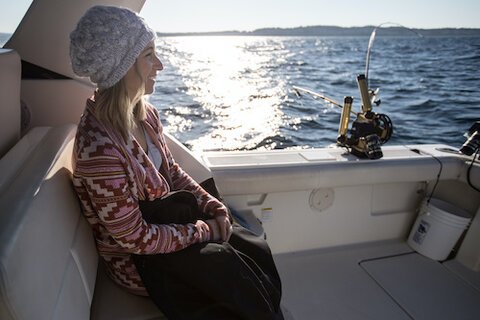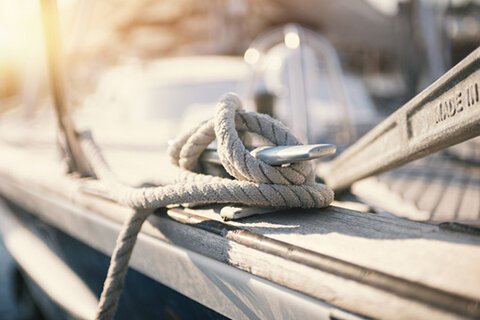An unfamiliar marina could challenge your maneuvering skills. Here’s what you need to know to dock your boat right the first time.
By Capt. Stuart Reininger
I had just tied up at the transient dock of a busy marina on the Intracoastal Waterway and was heading for a cold one when I spotted a handsome 45-foot convertible coming in. The skipper approached the dock like a pro, shaping up for a perfect landing. That’s when things went terribly wrong.
A crew member on the foredeck tossed a line to the dock hand and, following the dock hand’s directions, secured the bitter end to a bow cleat. The dock hand took the slack out of the line, tied it off, then wandered back to collect the stern line he had called for. The crew member, again, obeying the dock hand’s directions, moved aft to send him the line. The skipper, from his flybridge perch, might not have seen what had taken place. But if he did, he would not have been able to react quickly enough. The boat’s forward motion was checked by the secured bowline, which sprung the yacht onto a piling, creating a dramatic sculpture with the aid of what was once the bow pulpit.
By allowing the crew member to secure that bowline and walk away, the skipper effectively turned over the control of his boat to a perfect stranger: the dock hand. Sure, most dock hands are competent, but do you really want to risk your boat on that assumption? Dock lines need to be adjusted from aboard the boat so the operator has total control of his vessel at all times. This is particularly critical when you’re shaping up to dock in an unfamiliar place.
Many skippers will admit they have a tendency to blindly obey the directions of a dock hand when they’re approaching a slip in a strange marina. But as our friend on the 45-footer learned, that’s not the way to go. In my mind, maintaining control of your boat is of primary importance.
When approaching a new slip, the skipper has little choice but to dutifully follow the radioed directions from the dockmaster.
However, he is not at the helm of your boat and isn’t familiar with its handling characteristics. Imagine you’re running a single-screw displacement trawler and entering a yard that caters to stern-drive and outboard-powered boats. You may be asked to maneuver the boat in ways you are not familiar with or in ways the boat isn’t really capable of. I’ve been in that situation on more than a few occasions, particularly in the southern reaches of the ICW, where I’m often entering strange marinas or places I haven’t visited in a long time.If I can’t eyeball an assigned berth from out in the stream — especially if I have to wind and weave my way between a narrow gauntlet of berthed vessels before locating my slip — I’m going to ask myself a few important questions. First, is there enough room for me to make a safe 180 and then get out of dodge if the situation gets dicey? (Think rapidly shoaling water or a sudden encounter with a disabled vessel or discovering the slip is inappropriate for your boat.) If I can’t make that 180, I have to wonder if the boat I’m operating is capable of navigating astern to safe water. Finally, I have to question if there is enough room for two relatively large vessels to safely pass within the confines of the marina’s channel. I’ll want to know if berthed vessels are completely within the piling line without pulpits, anchors or davits extending beyond that line.
I like to see boats set well back in a slip. In my opinion, that’s the sign of a well-run and professional yard. This setup allows the skipper of an incoming (or outgoing) boat to lie against those pilings without damaging a berthed boat or his own. That’s something you might have to do in the event of an emergency, such as engine or transmission failure, or to allow for the close passage of another vessel. An outlying slip piling also can be utilized as a pivoting platform from which to "spring" into the berth if extreme wind and/ or current are present or if the engine, prop gear or transmission fails on a twin-screw boat.
There’s a lot to consider before you enter a marina that is new to you. For that reason, it makes sense to contact the dockmaster in advance of your arrival. Ask him for a description of the exact location of the assigned slip and make sure he’s aware and familiar with the particular requirements of your boat.
I’m usually operating larger boats when marina-hopping, but I’ve noticed owners of smaller boats have to deal with their own unique problems. What do you do, for instance, when your 30-foot cruiser is assigned a slip usually occupied by a much larger yacht? You may be confronted by towering and far-spaced pilings that can make it difficult, if not impossible, to safely deploy your lines or get fenders in the right place. And what do you do about an amperage supply sufficient for a small city and no way to step it down to your 30-amp requirements? Essentially, you need to know this beforehand. It boils down to doing the homework, which, for the skipper headed into strange waters, is as essential as plotting positions and fuel curves.
Remember, a strange marina is only a stranger once. However, it’s always a good idea to doublecheck the layout of any marina you plan to visit, even if you’ve been there once or twice before.
Shared with permission by MotorBoating.


